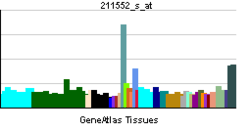Aldehyde dehydrogenase 4 family, member A1
| View/Edit Human | View/Edit Mouse |
Delta-1-pyrroline-5-carboxylate dehydrogenase, mitochondrial is an enzyme that in humans is encoded by the ALDH4A1 gene.[3][4]
This protein belongs to the aldehyde dehydrogenase family of proteins. This enzyme is a mitochondrial matrix NAD-dependent dehydrogenase that catalyzes the second step of the proline degradation pathway, converting pyrroline-5-carboxylate to glutamate. Deficiency of this enzyme is associated with type II hyperprolinemia, an autosomal recessive disorder characterized by accumulation of delta-1-pyrroline-5-carboxylate (P5C) and proline. Two transcript variants encoding the same protein have been identified for this gene.[4]
References
- ↑ "Human PubMed Reference:".
- ↑ "Mouse PubMed Reference:".
- ↑ Hu CA, Lin WW, Valle D (Jun 1996). "Cloning, characterization, and expression of cDNAs encoding human delta 1-pyrroline-5-carboxylate dehydrogenase". J Biol Chem. 271 (16): 9795–800. doi:10.1074/jbc.271.16.9795. PMID 8621661.
- 1 2 "Entrez Gene: ALDH4A1 aldehyde dehydrogenase 4 family, member A1".
Further reading
- Valle D, Goodman SI, Harris SC, Phang JM (1980). "Genetic evidence for a common enzyme catalyzing the second step in the degradation of proline and hydroxyproline.". J. Clin. Invest. 64 (5): 1365–70. doi:10.1172/JCI109593. PMC 371284
 . PMID 500817.
. PMID 500817. - Hochstrasser DF, Frutiger S, Paquet N, et al. (1993). "Human liver protein map: a reference database established by microsequencing and gel comparison.". Electrophoresis. 13 (12): 992–1001. doi:10.1002/elps.11501301201. PMID 1286669.
- Goodman SI, Mace JW, Miles BS, et al. (1974). "Defective hydroxyproline metabolism in type II hyperprolinemia.". Biochemical medicine. 10 (4): 329–36. doi:10.1016/0006-2944(74)90036-2. PMID 4851275.
- Maruyama K, Sugano S (1994). "Oligo-capping: a simple method to replace the cap structure of eukaryotic mRNAs with oligoribonucleotides.". Gene. 138 (1-2): 171–4. doi:10.1016/0378-1119(94)90802-8. PMID 8125298.
- Suzuki Y, Yoshitomo-Nakagawa K, Maruyama K, et al. (1997). "Construction and characterization of a full length-enriched and a 5'-end-enriched cDNA library.". Gene. 200 (1-2): 149–56. doi:10.1016/S0378-1119(97)00411-3. PMID 9373149.
- Geraghty MT, Vaughn D, Nicholson AJ, et al. (1998). "Mutations in the Delta1-pyrroline 5-carboxylate dehydrogenase gene cause type II hyperprolinemia.". Hum. Mol. Genet. 7 (9): 1411–5. doi:10.1093/hmg/7.9.1411. PMID 9700195.
- Strausberg RL, Feingold EA, Grouse LH, et al. (2003). "Generation and initial analysis of more than 15,000 full-length human and mouse cDNA sequences.". Proc. Natl. Acad. Sci. U.S.A. 99 (26): 16899–903. doi:10.1073/pnas.242603899. PMC 139241
 . PMID 12477932.
. PMID 12477932. - Twizere JC, Kruys V, Lefèbvre L, et al. (2004). "Interaction of retroviral Tax oncoproteins with tristetraprolin and regulation of tumor necrosis factor-alpha expression.". J. Natl. Cancer Inst. 95 (24): 1846–59. doi:10.1093/jnci/djg118. PMID 14679154.
- Yoon KA, Nakamura Y, Arakawa H (2004). "Identification of ALDH4 as a p53-inducible gene and its protective role in cellular stresses.". J. Hum. Genet. 49 (3): 134–40. doi:10.1007/s10038-003-0122-3. PMID 14986171.
- Gerhard DS, Wagner L, Feingold EA, et al. (2004). "The status, quality, and expansion of the NIH full-length cDNA project: the Mammalian Gene Collection (MGC).". Genome Res. 14 (10B): 2121–7. doi:10.1101/gr.2596504. PMC 528928
 . PMID 15489334.
. PMID 15489334. - Gregory SG, Barlow KF, McLay KE, et al. (2006). "The DNA sequence and biological annotation of human chromosome 1.". Nature. 441 (7091): 315–21. doi:10.1038/nature04727. PMID 16710414.
This article is issued from Wikipedia - version of the 5/24/2016. The text is available under the Creative Commons Attribution/Share Alike but additional terms may apply for the media files.

